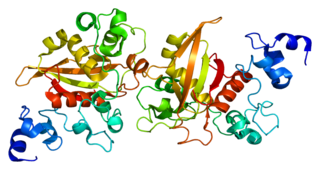Neurogenic locus notch homolog 4(Notch 4) is a protein that in humans is encoded by the NOTCH4 gene located on chromosome 6. [5]
Neurogenic locus notch homolog 4(Notch 4) is a protein that in humans is encoded by the NOTCH4 gene located on chromosome 6. [5]
An alternative splice variant of the NOTCH4 gene has been described, but its biological significance has not been determined. [6]
The neurogenic locus notch homolog 4 protein is a member of the Notch family. Members of this type 1 transmembrane protein family share structural characteristics. These include an extracellular domain consisting of multiple epidermal growth factor-like (EGF) repeats, and an intracellular domain that consists of multiple, but different, domain types.
Notch protein family members play a role in a variety of developmental processes by controlling cell fate decisions. The Notch signaling pathway is an evolutionarily conserved intercellular signaling pathway that regulates interactions between physically adjacent cells
In Drosophila, notch interacts with its cell-bound ligands (delta and serrate), and establishes an intercellular signaling pathway that then plays a key role in development. Homologues of the notch-ligands have also been identified in humans, but precise interactions between these ligands and the human notch homologues remain to be determined. The notch protein is cleaved in the trans-Golgi network, and then presented on the cell surface as a heterodimer. The protein functions as a receptor for membrane bound ligands, and may play a role in vascular, renal, and hepatic development. [6]
Mutations in the notch4 gene may be associated with susceptibility to schizophrenia in a small portion of cases. [7]

Neurogenic locus notch homolog protein 3(Notch 3) is a protein that in humans is encoded by the NOTCH3 gene.

Jagged1 (JAG1) is one of five cell surface proteins (ligands) that interact with four receptors in the mammalian Notch signaling pathway. The Notch Signaling Pathway is a highly conserved pathway that functions to establish and regulate cell fate decisions in many organ systems. Once the JAG1-NOTCH (receptor-ligand) interactions take place, a cascade of proteolytic cleavages is triggered resulting in activation of the transcription for downstream target genes. Located on human chromosome 20, the JAG1 gene is expressed in multiple organ systems in the body and causes the autosomal dominant disorder Alagille syndrome (ALGS) resulting from loss of function mutations within the gene. JAG1 has also been designated as CD339.

Neurogenic locus notch homolog protein 1(Notch 1) is a protein encoded in humans by the NOTCH1 gene. Notch 1 is a single-pass transmembrane receptor.

Proto-oncogene Wnt-1, or Proto-oncogene Int-1 homolog is a protein that in humans is encoded by the WNT1 gene.

Neurogenic locus notch homolog protein 2 is a protein that in humans is encoded by the NOTCH2 gene.

Cadherin EGF LAG seven-pass G-type receptor 2 is a protein that in humans is encoded by the CELSR2 gene.

Frizzled-5(Fz-5) is a protein that in humans is encoded by the FZD5 gene.

Frizzled-3(Fz-3) is a protein that in humans is encoded by the FZD3 gene.

Cadherin EGF LAG seven-pass G-type receptor 1 also known as flamingo homolog 2 or cadherin family member 9 is a protein that in humans is encoded by the CELSR1 gene.

Indian hedgehog homolog (Drosophila), also known as IHH, is a protein which in humans is encoded by the IHH gene. This cell signaling protein is in the hedgehog signaling pathway. The several mammalian variants of the Drosophila hedgehog gene (which was the first named) have been named after the various species of hedgehog; the Indian hedgehog is honored by this one. The gene is not specific to Indian hedgehogs.

Slit homolog 2 protein is a protein that in humans is encoded by the SLIT2 gene.

Teratocarcinoma-derived growth factor 1 is a protein that in humans is encoded by the TDGF1 gene. The protein is an extracellular, membrane-bound signaling protein that plays an essential role in embryonic development and tumor growth. Mutations in this gene are associated with forebrain defects. Pseudogenes of this gene are found on chromosomes 2, 3, 6, 8, 19 and X. Alternate splicing results in multiple transcript variants.

Roundabout homolog 1 is a protein that in humans is encoded by the ROBO1 gene.

Neuronal cell adhesion molecule is a protein that in humans is encoded by the NRCAM gene.

Large tumor suppressor kinase 1 (LATS1) is an enzyme that in humans is encoded by the LATS1 gene.

Msx2-interacting protein is a protein that in humans is encoded by the SPEN gene.

Jagged-2 is a protein that in humans is encoded by the JAG2 gene.

Protein deltex-2 also known as E3 ubiquitin-protein ligase DTX2 is an enzyme that in humans is encoded by the DTX2 gene.

Beta-1,3-N-acetylglucosaminyltransferase manic fringe is an enzyme that in humans is encoded by the MFNG gene, a member of the fringe gene family which also includes the radical fringe (RFNG) and lunatic fringe (LFNG).

Large tumor suppressor kinase 2 (LATS2) is an enzyme that in humans is encoded by the LATS2 gene.